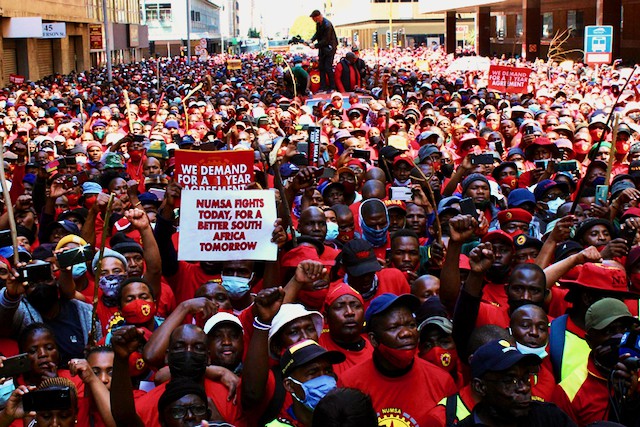Steel strike continues as NUMSA members reject SEIFSA offer
Investigation ongoing into security guards accused of using live ammunition on striking workers
Thousands of National Union of Metalworkers of South Africa members working in the engineering sector marched to the Metal and Engineering Industries Bargaining Council in Johannesburg on 5 October, marking the beginning of the ongoing strike. Photo: Masego Mafata
The steel and engineering strike is set to continue as the National Union of Metalworkers of South Africa (NUMSA) has failed to reach an agreement with the Steel and Engineering Industries Federation of Southern Africa (SEIFSA).
According to Irvin Jim, NUMSA general secretary, SEIFSA increased its wage offer from 4.4% to 6%. The union was initially demanding an 8% wage increase. (SEIFSA represents companies that employ more than 150,000 workers in the metal and engineering sector.)
“There is consensus between NUMSA and SEIFSA on a number of elements that would form part of a three-year agreement. The union is prepared to settle on 6%, but the union demands that it cannot be paid [calculated] on minimums and must be paid on the actual rates of pay,” Jim said at a press conference in Johannesburg on Thursday.
Jim said that should employer associations fail to come to the table to settle the strike, the union will have no choice but to issue a secondary strike notice that will “shut down the economy”.
“The strike is negatively affecting our members, the sector and the economy. Workers are basically starving. They don’t have money and food. It is not just the economy that suffers, it is workers too,” he said.
Jim criticised the National Employers Association of South Africa (NEASA), Consolidated Employers Organisation and South African Engineers and Founders Association for “refusing to negotiate meaningfully”.
After the press conference, he said that together with NUMSA bargaining representatives, he was going to attend a meeting convened under Section 150 of the Labour Relations Act. (According to the Act, this means a commissioner has been appointed to assist the parties to resolve, through further conciliation, the current dispute.)
“We only hope that they are going to use this Section 150 to make a meaningful offer that can resolve the strike. SEIFSA said they are going back to the drawing board. We are available to engage with them when they are ready. The strike continues until such time there is an offer on the table that can settle this round of negotiations,” he said.
SEIFSA will host a press briefing on Friday on the industry wage negotiations and its offer to end the strike.
Allegations of live ammunition used on strikers
Meanwhile, four security guards arrested by police for allegedly using live ammunition on picketing workers in Steeldale, south of Johannesburg, were released by the Booysens Magistrate’s Court on 6 October, according to Captain Tsietsi Jeff Phora, spokesperson for Johannesburg SAPS.
He said the four suspects were employed by National Security and Fire. They were arrested on 5 October and detained at SAPS Moffatview. This came after picketing NUMSA members clashed with the guards at Revive Electrical Transformers in Steeldale. The suspects appeared in court on 6 October, facing attempted murder charges.
“All firearms that were allegedly involved in the shooting were taken for ballistic tests by police. We are waiting for both the ballistic and residue results as the investigation into this case continues,” he said.
Bafana Cebekulu, a shop steward, who says he witnessed the incident, said they were initially at KK Engineering where they spoke to the employers and asked them to release workers [to join the strike]. “They were not happy but they agreed,” he said.
Their group then moved to nearby company Revive, to demand that its workers also be released.
“There were two National Security bakkies near Revive and after a while, another three arrived,” he said.
According to Cebekulu tensions escalated when one of the security guards started taking pictures of the group, and one of the picketing workers tried to stop him.
According to National Security and Fire general manager Gerhard Oberholzer, security guards were hit with bricks and sticks by some of the picketers.
“Initially our guards were observing and taking photographs. The group [of picketers] became more distressed and tried to stop one of the guards from taking photographs,” he said.
Oberholzer said it was only after some picketers attacked the guard that other guards retaliated.
Cebekulu said it was difficult to see how many people were shot and injured as the crowd dispersed. “I know of two people who were shot and injured but because they’re not working at the same factory as me, it is difficult to track them down and find out how they are doing,” he said.
There have been reports of striking workers intimidating people.
NUMSA has condemned all incidents of violence and criminal activity. “We condemn the heavy-handedness of police and private security companies. We also call on all NUMSA members not to undermine their own struggle by acting unlawfully,” said Phakamile Hlubi-Majola, NUMSA spokesperson.
Next: Cele promises action after Gqeberha violence
Previous: Cape Town home owners, fed up with City’s lack of action, pay to house homeless
© 2021 GroundUp. This article is licensed under a Creative Commons Attribution-NoDerivatives 4.0 International License.
You may republish this article, so long as you credit the authors and GroundUp, and do not change the text. Please include a link back to the original article.
We put an invisible pixel in the article so that we can count traffic to republishers. All analytics tools are solely on our servers. We do not give our logs to any third party. Logs are deleted after two weeks. We do not use any IP address identifying information except to count regional traffic. We are solely interested in counting hits, not tracking users. If you republish, please do not delete the invisible pixel.



